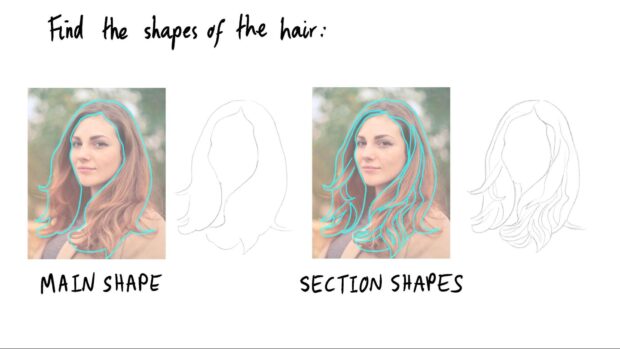Learn How To Draw Hair in 4 Simple Steps
16Jun
Learning how to draw hair can seem like an overwhelming task. With so many strands of hair, it’s difficult to know where to begin! In this tutorial, I’ll show you how to draw hair in four simple steps. This easy-to-follow process will take the stress out of drawing realistic hair.Drawing supplies for this project:
Step One: Focus on shapesThe bulk of the hair consists of thousands of individual strands. Even if we could see all the strands, they would be very time-consuming to draw. The key to drawing hair is to break it down into simple shapes. First, lightly draw the outline of the hair’s overall shape using a lighter pencil like a 2H. Then, draw the shapes that make up the sections of hair. Sections of hair form when the individual strands clump together in curls or waves. For long wavy hair, these sections often look like long ‘s’ shapes. If you are working from a photograph, take your time and draw the main shapes that you see. Think of the sections as puzzle pieces that fit together.Step Two: Show the direction of the hairNow, add the direction of the hair inside each shape. Use the flicking motion with your pencil to add a few lines that follow the flow of the hair in each section. This will help to create the natural waviness and movement of the hair. It is important to keep your lines very light until we add shading in the next step.How to use a flicking motion:Draw long fluid lines, working from your elbow to move your hand smoothly across the paper. Allow your pencil marks to fade to a thin point as you release the pencil from the paper at the end of each line ending with the “flick” motion.Step Three: Find light and dark areasAt this point, we can start adding some simple shading. To create depth in the hair, we need to shade light, middle, and dark tonal values. First, draw shapes for the highlights (where the light hits the hair directly). Leave these highlighted areas blank so the white of paper comes through. Next, find the mid-tones and dark areas of the hair to shade. Use a 2B pencil to shade with. If you prefer a smooth look, you could use a blending stump or Q-tip to soften your shading. In our example, the darkest areas are around the face and directly under the layered hair sections. | ||||||||||||||

Comments
